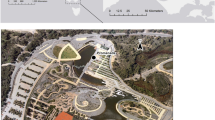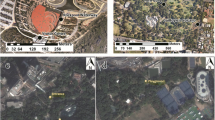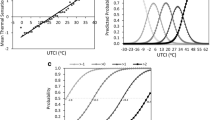Abstract
The chapter looks at human acclimatization in the short and in the long term with respect to intercations between reported thermal perception, monitored meteorological variables and calculated UTCI data. Two different perspectives are employed to investigate both issues: responses from 16 participants in a longitudinal study using a controlled thermal environment (climate chamber) and responses from a cross-sectional study with local population. In both cases, outdoor data were monitored and compared to participants’ thermal responses. In the longitudinal study, a 5-h exposure in a controlled thermal environment preceded a 30-min period outdoors, during which standard standard thermal comfort questionnaires were administered at three time stamps along with the monitoring of meteorological data for assessing potential short-term acclimatization effects. In the cross-sectional study, reported thermal history was used as an indicator of short-term acclimatization. For the evaluation of long-term acclimatization, two approaches have been used: in the longitudinal study, changes in thermal votes were compared over three seasons of the year; in the cross-sectional study, we compared thermal responses from two populations living under different climatic conditions but subject to summer conditions (Guangzhou/Zhuhai and Melbourne). The UTCI was used as a relevant thermal index for assessing acclimatization effects. The method of analysis also differed between studies: in the longitudinal study, a dynamic approach was used with trend analysis over time; in the cross-sectional study, comparisons were made using right-here-right-now responses performing cluster analysis, followed by t-test and chi-square test of independence.
Access this chapter
Tax calculation will be finalised at checkout
Purchases are for personal use only
Similar content being viewed by others

References
Acero JA, Koh EJ, Pignatta G, Norford LK (2020) Clustering weather types for urban outdoor thermal comfort evaluation in a tropical area. Theoret Appl Climatol 139(1):659–675
ASHRAE (2017) ANSI/ASHRAE Standard 55—thermal environmental conditions for human occupancy. ASHRAE, Atlanta, GA
Basarin B, Lukić T, Matzarakis A (2020) Review of biometeorology of heatwaves and warm extremes in Europe. Atmosphere 11(12):1276
Becker S, Potchter O, Yaakov Y (2003) Calculated and observed human thermal sensation in an extremely hot and dry climate. Energy Build 35(8):747–756
Bennetts H, Arakawa Martins L, van Hoof J, Soebarto V (2020) Thermal personalities of older people in South Australia: a personas-based approach to develop thermal comfort guidelines. Int J Environ Res Public Health 17(22):8402
Błażejczyk K, Błażejczyk M (2010) BioKlima© 2.6, Program komputerowy. http://www.igipz.pan.pl/Bioklima-zgik.html
Bridges CC Jr (1966) Hierarchical cluster analysis. Psychol Rep 18(3):851–854
Bröde P, Fiala D, Błażejczyk K, Holmér I, Jendritzky G, Kampmann B, … Havenith G (2012) Deriving the operational procedure for the Universal Thermal Climate Index (UTCI). Int J Biometeorol 56(3):481–494
Bureau of Meteorology (2015) Melbourne in 2014: another warm year with below average rainfall. Bureau of Meteorology. http://www.bom.gov.au/climate/current/annual/vic/archive/2014.melbourne.shtml. Accessed 12 Oct 2020
Bureau of Meteorology (2020) Climate statistics for Australian locations: summary statistics Melbourne regional office. Bureau of Meteorology. http://www.bom.gov.au/climate/averages/tables/cw_086071.shtml. Accessed 8 July 2020
Cabanac M (1971) Physiological role of pleasure. Science 173(4002):1103–1107
Cândido C, De Dear R, Lamberts R, Bittencourt L (2010) Cooling exposure in hot humid climates: are occupants ‘addicted’? Architect Sci Rev 53(1):59–64
Cheung PK, Jim CY (2019) Improved assessment of outdoor thermal comfort: 1-hour acceptable temperature range. Build Environ 151:303–317
China Meteorological Administration (2012) Chinese surface weather station monthly climate dataset (1981–2010). National Meteorological Information Center. http://data.cma.cn/data/cdcdetail/dataCode/A.0029.0004.html. Accessed 9 Oct 2020
Chinazzo G, Wienold J, Andersen M (2019) Daylight affects human thermal perception. Sci Rep 9(1):1–15
Coutts AM, White EC, Tapper NJ, Beringer J, Livesley SJ (2016) Temperature and human thermal comfort effects of street trees across three contrasting street canyon environments. Theoret Appl Climatol 124(1–2):55–68
De Dear R (2011) Revisiting an old hypothesis of human thermal perception: alliesthesia. Build Res Inf 39(2):108–117
De Dear R, Brager GS (2001) The adaptive model of thermal comfort and energy conservation in the built environment. Int J Biometeorol 45(2):100–108
De Dear RJ, Ring JW, Fanger PO (1993) Thermal sensations resulting from sudden ambient temperature changes. Indoor Air 3(3):181–192
De Freitas CR, Grigorieva EA (2009) The Acclimatization Thermal Strain Index (ATSI): a preliminary study of the methodology applied to climatic conditions of the Russian Far East. Int J Biometeorol 53(4):307–315
De Freitas CR, Grigorieva EA (2014) The impact of acclimatization on thermophysiological strain for contrasting regional climates. Int J Biometeorol 58(10):2129–2137
Fiala D, Havenith G, Bröde P, Kampmann B, Jendritzky G (2012) UTCI-Fiala multi-node model of human heat transfer and temperature regulation. Int J Biometeorol 56(3):429–441
Gauthier S, Bourikas L, Al‐Atrash F, Bae C, Chun C, de Dear R, … Wagner A (2020) The colours of comfort: from thermal sensation to person-centric thermal zones for adaptive building strategies. Energy Build 216:109936
Gosling SN, Bryce EK, Dixon PG, Gabriel KM, Gosling EY, Hanes JM, … Wanka ER (2014) A glossary for biometeorology. Int J Biometeorol 58(2):277–308
Hanna EG, Tait PW (2015) Limitations to thermoregulation and acclimatization challenge human adaptation to global warming. Int J Environ Res Public Health 12(7):8034–8074
Hartigan JA, Wong MA (1979) AK-means clustering algorithm. J Roy Stat Soc Ser C (Appl Stat) 28(1):100–108
Heng SL, Chow WT (2019) How ‘hot’ is too hot? Evaluating acceptable outdoor thermal comfort ranges in an equatorial urban park. Int J Biometeorol 63(6):801–816
Höppe P (2002) Different aspects of assessing indoor and outdoor thermal comfort. Energy Build 34(6):661–665
Humphreys MA, Nicol JF, Raja IA (2007) Field studies of indoor thermal comfort and the progress of the adaptive approach. Adv Build Energy Res 1(1):55–88
ISO 7726 (2001) Ergonomics of the thermal environment. Instruments for measuring physical quantities. International Organization for Standardization (ISO), Geneva
ISO 7730 (2005) Moderate thermal environment—determination of the PMV and PPD indices and specification of the conditions for thermal comfort. International Organization for Standardization, Geneva
ISO 9920 (2007) Ergonomics of the thermal environment—estimation of thermal insulation and water vapour resistance of a clothing ensemble. International Organization for Standardization, Geneva
ISO 10551 (2019) Ergonomics of the thermal environment—assessment of the influence of the thermal environment using subjective judgement scales. International Organization for Standardization, Geneva
Jayathissa P, Quintana M, Sood T, Nazarian N, Miller C (2019) Is your clock-face cozie? A smartwatch methodology for the in-situ collection of occupant comfort data, in Journal of Physics: Conference Series, vol. 1343, no. 1. IOP Publishing, p. 012145
Ji W, Cao B, Geng Y, Zhu Y, Lin B (2019) A study on the influences of immediate thermal history on current thermal sensation. Energy Build 198:364–376
Kántor N, Kovács A, Takács Á (2016) Seasonal differences in the subjective assessment of outdoor thermal conditions and the impact of analysis techniques on the obtained results. Int J Biometeorol 60(11):1615–1635
Klemm W, van Hove B, Lenzholzer S, Kramer H (2017) Towards guidelines for designing parks of the future. Urban For Urban Green 21:134–145
Knez I, Thorsson S, Eliasson I, Lindberg F (2009) Psychological mechanisms in outdoor place and weather assessment: towards a conceptual model. Int J Biometeorol 53(1):101–111
Ko WH, Schiavon S, Zhang H, Graham LT, Brager G, Mauss I, Lin YW (2020) The impact of a view from a window on thermal comfort, emotion, and cognitive performance. Build Environ 175:106779
Kottek M, Grieser J, Beck C, Rudolf B, Rubel F (2006) World map of the Köppen-Geiger climate classification updated
Krüger E, Drach P, Bröde P (2015) Implications of air-conditioning use on thermal perception in open spaces: a field study in downtown Rio de Janeiro. Build Environ 94:417–425
Krüger EL, Tamura CA, Bröde P, Schweiker M, Wagner A (2017) Short-and long-term acclimatization in outdoor spaces: exposure time, seasonal and heatwave adaptation effects. Build Environ 116:17–29
Krüger EL, Costa T (2019) Interferences of urban form on human thermal perception. Sci Total Environ 653:1067–1076
Lai D, Lian Z, Liu W, Guo C, Liu W, Liu K, Chen Q (2020) A comprehensive review of thermal comfort studies in urban open spaces. Sci Total Environ 140092
Lam CKC, Lau KKL (2018) Effect of long-term acclimatization on summer thermal comfort in outdoor spaces: a comparative study between Melbourne and Hong Kong. Int J Biometeorol 62(7):1311–1324
Lam CKC, Gallant AJ, Tapper NJ (2018) Perceptions of thermal comfort in heatwave and non-heatwave conditions in Melbourne, Australia. Urban Climate 23:204–218
Lam CKC, Gallant AJ, Tapper NJ (2019) Short-term changes in thermal perception associated with heatwave conditions in Melbourne, Australia. Theo Appl Climatol 136(1):651–660
Lam CKC, Yang H, Yang X, Liu J, Ou C, Cui S, … Hang J (2020) Cross-modal effects of thermal and visual conditions on outdoor thermal and visual comfort perception. Build Environ 186:107297
Lam CKC, Cui S, Liu J, Kong X, Ou C, Hang J (2021a) Influence of acclimatization and short-term thermal history on outdoor thermal comfort in subtropical South China. Energy Build 231:110541
Lam CKC, Gao Y, Yang H, Chen T, Zhang Y, Ou C, Hang J (2021b) Interactive effect between long-term and short-term thermal history on outdoor thermal comfort: comparison between Guangzhou, Zhuhai and Melbourne. Sci Total Environ 760:144141
Lenzholzer S (2010) Engrained experience—a comparison of microclimate perception schemata and microclimate measurements in Dutch urban squares. Int J Biometeorol 54(2):141–150
Lenzholzer S, Koh J (2010) Immersed in microclimatic space: microclimate experience and perception of spatial configurations in Dutch squares. Landscape Urban Plan 95(1–2):1–15
Lenzholzer S, de Vries S (2020) Exploring outdoor thermal perception—a revised model. Int J Biometeorol 64(2):293–300
Lin P, Gou Z, Lau SSY, Qin H (2017) The impact of urban design descriptors on outdoor thermal environment: a literature review. Energies 10(12):2151
Lin TP, De Dear R, Hwang RL (2011) Effect of thermal adaptation on seasonal outdoor thermal comfort. Int J Climatol 31(2):302–312
Lomax RG, Hahs-Vaughn DL (2020) Inferences about proportions. In: An introduction to statistical concepts, 4th edn. Routledge, New York, pp 291–338
McIntyre DA (1980) Indoor climate. Applied Science Publishers, London
Muthers S, Laschewski G, Matzarakis A (2017) The summers 2003 and 2015 in south-west Germany: heat waves and heat-related mortality in the context of climate change. Atmosphere 8(11):224
Nasrollahi N, Hatami Z, Taleghani M (2017) Development of outdoor thermal comfort model for tourists in urban historical areas; a case study in Isfahan. Build Environ 125:356–372
Nazarian N, Lee JKW (2020) Personal assessment of urban heat exposure: a systematic review. Environ Res Lett
Nazarian N, Liu S, Kohler M, Lee JK, Miller C, Chow WT, … Norford LK (2021) Project Coolbit: can your watch predict heat stress and thermal comfort sensation? Environ Res Lett 16(3):034031
Nikolopoulou M, Steemers K (2003) Thermal comfort and psychological adaptation as a guide for designing urban spaces. Energy Build 35(1):95–101
Parkinson T, De Dear R (2015) Thermal pleasure in built environments: physiology of alliesthesia. Build Res Inf 43(3):288–301
Parkinson T, De Dear R, Candido C (2012) Perception of transient thermal environments: pleasure and alliesthesia. In: Proceedings of 7th Windsor Conference, Windsor, UK, April 2012
Pearlmutter D, Bitan A, Berliner P (1999) Microclimatic analysis of “compact” urban canyons in an arid zone. Atmos Environ 33(24–25):4143–4150
Pearlmutter D, Berliner P, Shaviv E (2007) Integrated modeling of pedestrian energy exchange and thermal comfort in urban street canyons. Build Environ 42(6):2396–2409
Peel MC, Finlayson BL, McMahon TA (2007) Updated world map of the Köppen-Geiger climate classification. Hydrol Earth Syst Sci 11(5):1633–1644
Pigliautile I, Pisello AL (2020) Environmental data clustering analysis through wearable sensing techniques: new bottom-up process aimed to identify intra-urban granular morphologies from pedestrian transects. Build Environ 171:106641
Richards M, Havenith G (2007) Progress towards the final UTCI model. In: Mekjavic I, Kounalakis S, Taylor N (eds) Environmental Ergonomics XII, Biomed, Ljubljana, Piran Slovenia, 19–24 August 2007, pp 521–524
Rutty M, Scott D (2015) Bioclimatic comfort and the thermal perceptions and preferences of beach tourists. Int J Biometeorol 59(1):37–45
Schlader ZJ, Simmons SE, Stannard SR, Mündel T (2011) The independent roles of temperature and thermal perception in the control of human thermoregulatory behavior. Physiol Behav 103(2):217–224
Schweiker M, Brasche S, Hawighorst M, Bischof W, Wagner A (2014) Presenting LOBSTER, an innovative climate chamber, and the analysis of the effect of a ceiling fan on the thermal sensation and performance under summer conditions in an office-like setting. In: Windsor conference: counting the cost of comfort in a changing World, Windsor, UK, April 2014
Schweiker M, Ampatzi E, Andargie MS, Andersen RK, Azar E, Barthelmes VM, … Zhang S (2020a) Review of multi‐domain approaches to indoor environmental perception and behaviour. Build Environ 176:106804
Schweiker M, Rissetto R, Wagner A (2020b) Thermal expectation: influencing factors and its effect on thermal perception. Energy Build 210:109729
Schweiker M, Schakib-Ekbatan K, Fuchs X, Becker S (2020c) A seasonal approach to alliesthesia. Is there a conflict with thermal adaptation? Energy Build 212:109745
Sharpe D (2015) Chi-square test is statistically significant: now what? Pract Assess Res Evaluat 20(1):8
Shooshtarian S (2019) Theoretical dimension of outdoor thermal comfort research. Sustain Cities Soc 47:101495
Shooshtarian S, Rajagopalan P, Sagoo A (2018) A comprehensive review of thermal adaptive strategies in outdoor spaces. Sustain Cities Soc 41:647–665
Sood T, Janssen P, Miller C (2020) Spacematch: using environmental preferences to match occupants to suitable activity-based workspaces. Front Built Environ 6(113)
Spagnolo J, De Dear R (2003) A field study of thermal comfort in outdoor and semi-outdoor environments in subtropical Sydney Australia. Build Environ 38(5):721–738
Sturman AP, Tapper NJ (2006) The weather and climate of Australia and New Zealand, 2nd edn. Oxford University Press, Melbourne, Australia
Tamura C, Krüger E, Schweiker M, Moosman C, Wagner A (2017) Visual perception and daylight variables: experiments in a climate chamber. In: 33rd PLEA international conference-design to Thrive, Edinburgh, July 2017, pp 3396–3403
Taylor NAS (2014) Human heat adaptation. Comprehen Physiol 4:325–365
Wagner A, O’Brien W, Dong B (2018) Exploring occupant behavior in buildings—methods and challenges. Springer International Publishing, Cham, Switzerland
Willmott CJ (1981) On the validation of models. Phys Geogr 2(2):184–194
Xue J, Hu X, Sani SN, Wu Y, Li X, Chai L, Lai D (2020) Outdoor thermal comfort at a University Campus: studies from personal and long-term thermal history perspectives. Sustainability 12(21):9284
Zhang Y, Chen H, Wang J, Meng Q (2016) Thermal comfort of people in the hot and humid area of China—impacts of season, climate, and thermal history. Indoor Air 26(5):820–830
Zhou Z, Deng Q, Yang W, Zhou J (2020) Effect of seasonal adaptation on outdoor thermal comfort in a hot-summer and cold-winter city. Adv Build Energy Res 14(2):202–217
Acknowledgements
We acknowledge the Brazilian research funding agency CAPES, the European Union 7th Framework Programme (FP7/2007–2013) grant agreement no. PIRG08-GA-2010-277061 and the Fachgebiet Bauphysik & Technischer Ausbau/Karlsruher Institut für Technologie (fbta/KIT), in special Marcel Schweiker and Andreas Wagner. For the cross-sectional study in Guangzhou and Zhuhai, we acknowledge the support by the National Natural Science Foundation of China (No. 41905005, No. 41875015, No. 51811530017), and the Natural Science Foundation of Guangdong Province, China (No. 2018A030310307, 2018B030311068). For the Melbourne survey, we acknowledge the CRC for Water Sensitive Cities and the Royal Botanic Garden Victoria (RBGV) for their support. We also thank Cintia Tamura for the data collection in Karlsruhe and Yanping Gao for her assistance in analysing the survey data in Guangzhou, Zhuhai and Melbourne.
Author information
Authors and Affiliations
Corresponding author
Editor information
Editors and Affiliations
Rights and permissions
Copyright information
© 2021 The Author(s), under exclusive license to Springer Nature Switzerland AG
About this chapter
Cite this chapter
Lam, C.K.C., Krüger, E.L., Callejas, I.J.A., Wagner, A. (2021). Long and Short-Term Acclimatization Effects on Outdoor Thermal Perception Versus UTCI. In: Krüger, E.L. (eds) Applications of the Universal Thermal Climate Index UTCI in Biometeorology. Biometeorology, vol 4. Springer, Cham. https://doi.org/10.1007/978-3-030-76716-7_5
Download citation
DOI: https://doi.org/10.1007/978-3-030-76716-7_5
Published:
Publisher Name: Springer, Cham
Print ISBN: 978-3-030-76715-0
Online ISBN: 978-3-030-76716-7
eBook Packages: Earth and Environmental ScienceEarth and Environmental Science (R0)



